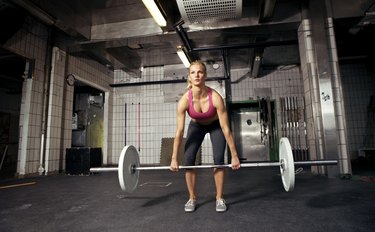
Your strength-to-weight ratio is simply your strength divided by your body weight. The ideal ratio depends on your gender and what lift you're performing. Competitive athletes' goals for the strength-to-weight ratio differ from those for the average gym-goer.
Regardless of your experience level, think of strength-to-weight ratios in terms of progress; you want to see improvements in the ratio as you train to help you become more adept at your sport, not necessarily work toward a specific ideal.
Video of the Day
Video of the Day
Like any measure of fitness, dedicated focus on exercise and quality nutrition helps you see improvements in the ratio.
Read more: 9 Essential Strength Benchmarks for Men
Strength-to-Weight Ratios
Strength-to-weight ratio, or SWR, isn't about how much total weight you can move — it's about relative strength. It's simply your strength — or the amount of weight you can lift — divided by your body weight, as explained by College Sports Scholarships.
For example, a 150-pound man who can bench press 200 pounds has a strength-to-weight ratio for the chest of 1.3, expressed by: SWR = 200 / 150 = 1.3.
A 200-pound man who bench presses 210 pounds lifts more weight, but when you figure his strength-to-weight ratio, it's lower: SWR = 210 / 200 = 1.05.
Strength-to-weight ratios can be different for various lifts and muscle groups. For example, you may have a high SWR for the bench press, but a notably lower one for a squat or deadlift.
This could indicate a relative imbalance between the strength and performance of the muscles of the upper and lower body, or it could be a reflection of your training emphasis.
Figuring Your Total-Body SWR
To get the most accurate, total-body strength-to-weight ratio assessment, perform five different exercises. For strength athletes, this is usually the bench press, squat, deadlift, power clean and power snatch.
Lift the heaviest weight you can for one repetition, with proper form. Figure the SWR for each exercise and then add up the numbers. Divide the total by five — the number of exercises you performed — to get your strength-to-weight ratio profile.
For example, if the ratios for the exercises were 1.3, 1, 1.5, 0.9 and 0.6, you'd add them up to get 5.3 total. Then, divide 5.3 by 5 for a SWR profile of 1.06.
Consider All the Factors
In weightlifting or powerlifting, your strength-to-weight ratio is influenced by your gender. Men naturally carry more muscle mass and thus usually have a higher ratio than women.
For example, according to ExRx.net, an intermediate, 165-pound male powerlifter performing the deadlift ideally lifts about 295 pounds for a SWR of 1.8. A woman of the same weight and class ideally deadlifts 190 pounds, for a SWR of 1.15.
Of course, these numbers are based on competitive standards, and the average athlete might fall below these numbers.
The more trained you are in weight-training sports also determines your ideal strength-to-weight ratio. A novice lifter who has trained regularly for just a few months will usually have a lower SWR than an advanced lifter who has trained for multiple years.
Read more: Your Guide to Strength Training for Women
Applying SWR to Other Athletes
While strength-to-weight ratio is often used when discussing weight-training sports, it's important for any athlete. A high SWR usually means you can produce more power with every action — so you can run, swim and cycle faster.
In gymnastics, an athlete with a higher strength-to-weight ratio can perform better in suspension exercises, such as on the rings or parallel bars. A cyclist with a higher SWR can power up hills more quickly and efficiently with less effort.
According to a November 2017 article published by Arab Journal of Nutrition and Exercise, body composition goals vary by sport. While adding muscle mass helps increase your strength-to-weight ratio when you are a weight- or powerlifter, you don't want to add too much excess muscle when you're an endurance athlete or a gymnast. A heavier, more muscular body means you have that much more weight to carry or propel through space.
Functional training with bodyweight exercises — such as pushups, pullups and core work — and reducing excess body fat with a healthy, portion-controlled diet, helps improve your strength-to-weight ratio. If you're already lean, though, losing weight isn't likely to help improve your strength-to-weight ratio.
You risk losing valuable muscle, which contributes to your overall strength. According to the American Council on Exercise, the average female athlete has a body fat of between 14 and 20 percent; the average male athlete, between 6 and 13 percent. Women naturally carry more fat than men due to the needs of childbearing.
- College Sports Scholarships: "Exercise Efficiency. Measure Body Fat or Strength to Weight Ratio?"
- ExRx.net: "Deadlift Standards"
- American Council on Exercise: "Percent Body Fat Calculator: Skinfold Method"
- Arab Journal of Nutrition and Exercise: "Weight Management for Athletes: Important Things to be Considered"